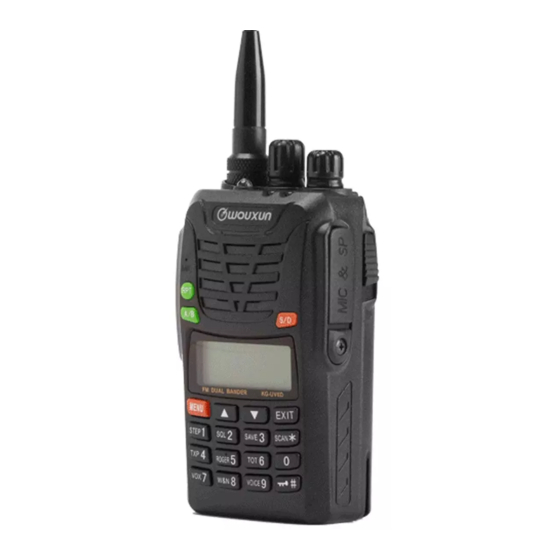Summary of Contents for Wouxun KG-UV6D
- Page 1 Wouxun KG-UV6D Wouxun KG-UV6X VHF/UHF Handheld FM Transceiver User's Manual Version 1.2, May 23rd, 2012...
-
Page 2: Table Of Contents
Table of Contents 1 Preface...............................................3 2 Front Panel Diagram.........................................4 3 LCD Display Diagram........................................5 4 Quick-Start Guide..........................................6 4.1 Switching Between Modes.......................................6 4.2 Menu Mode..........................................7 4.3 Programming a Repeater Frequency..................................7 4.4 Channel Mode Operations ......................................8 4.4.1 Channel Mode Sub-Modes....................................8 4.4.2 Odd Repeater Channel Offsets, Cross-band Settings............................9 4.4.3 Channel Memories......................................9 4.5 Dealer Mode..........................................9 5 Standby, Scanning, Reverse, Monitor, and DTMF.................................10... -
Page 3: Preface
Wouxun is not well organized and poorly translated. This revised manual addresses that shortcoming. This guide is designed to teach you how to manually program the radio. It will not duplicate some sections of the Wouxun manual (i.e. safety, description of functions, shortcut sheet, SOS function, wire cloning, charging, programming guide, troubleshooting, CTCSS-DCS charts, specifications, accessories, certifications). -
Page 4: Front Panel Diagram
2 Front Panel Diagram... -
Page 5: Lcd Display Diagram
3 LCD Display Diagram... -
Page 6: Quick-Start Guide
The mode determines what is shown on the LCD display and how the radio behaves. The two most important modes, VFO and Channel Mode, can also be toggled to display either dual or single frequencies. Note that “Frequency” and “Channel” modes as used by Wouxun correspond to “VFO”... -
Page 7: Menu Mode
To enter Menu Mode: MENU To exit Menu Mode: EXIT (or wait 5 seconds) To toggle FM Radio Mode on/off: Side Key 1 (the button immediately below the PTT button. See Section 8.2.1.) To enter Dealer Mode: see Section 4.5 below. 4.2 Menu Mode There are 32 menu items, some with numerous choices (parameters). -
Page 8: Channel Mode Operations
Toggle to VFO Mode: MENU S/D (there should be no channel numbers at right side of LCD display) Ensure frequency step is appropriate: MENU 1 MENU ▲ or ROTARY (until correct step is selected), MENU EXIT Enter receive frequency on keypad: Select CTCSS transmit tone: MENU ▲... -
Page 9: Odd Repeater Channel Offsets, Cross-Band Settings
Normally, amateur radio repeaters have an rx/tx offset of 600KHz on the 2M band, 1.6MHz on the 1.25M band and 5MHz on the 70CM band. If you wish to program an oddball offset or otherwise operate cross-band you can directly program such offsets with software or use what Wouxun refers to as “dis-channel”... -
Page 10: Standby, Scanning, Reverse, Monitor, And Dtmf
5 Standby, Scanning, Reverse, Monitor, and DTMF “Standby” is used by Wouxun to refer to watching activity on both frequencies (dual receive) when in dual frequency or dual channel modes, “Scanning” is an automatic frequency/channel change to detect busy frequencies, “Reverse” refers to receiving the transmit frequency of a repeater input and “Monitoring”... -
Page 11: Scanning Ctcss/Dcs
5.3 Scanning CTCSS/DCS This advanced feature enables one to scan for a signal that is being transmitted on a repeater input frequency and determine the CTCSS or DCS tone/code necessary to access that repeater. This function only works in VFO Mode on the master frequency (indicated with a ► arrow): Toggle to VFO Mode: MENU S/D (there should be no channel numbers at right side of LCD display). -
Page 12: Dtmf
5.7 DTMF DTMF encoding (touch tones) are available by pressing and holding the PTT button while at the same time pressing the required DTMF tone code keys on the keypad. For example, to access an IRLP link through a repeater you might enter the following codes: PTT hold, # 9 3 1 4 DTMF touch tones for A, B, C and D can be transmitted by pressing MENU , ▲... -
Page 13: Resets
Side Key 2 the lower. The KG-UV6 also has a circular green RPT multifunction key immediately above the A/B key. The Side Key 1 is sometimes designated “PF1” and the RPT key is “PF2” in the Wouxun manual. 8.1 RPT (PF2) Multi-function Key By default this RPT button selects between six different transmit/receive/repeater shift functions, with offsets using the frequency shift from Menu #24. -
Page 14: Side Key 1 (Pf1)
For example, assume that your shift in Menu #24 is set at 600KHz (00.600), and that you are in VFO mode with the receiver frequency set at 146.940 MHz. The results of each button press of the RPT key will be: 147.540 146.940 146.340... -
Page 15: 1750Hz Burst Tone
Some European repeaters require a 1750Hz burst tone for access. To generate this tone press PTT and Side Key 1 simultaneously. 8.2.3 SOS Function As this function is not appropriate to amateur radio it is not discussed here. Refer to the Wouxun manual if required. 8.3 Side Key 2 To turn on flashlight: Side Key 2 (short press) To activate “Monitor”... -
Page 16: Other Functions
9 Other Functions Thus far we have seen 20 of 32 menu items in action. Most of the other menu function items below are “set and forget” features: Set squelch level: MENU 2 MENU ▼ to select 0 through 9 MENU EXIT (5 is default and reasonable. -
Page 17: Software
(selects on which band to transmit the SOS function – see also Section 8.2 above.) 10 Software Ensure you have the correct Wouxun software* version specifically for the UV6 series radios as it has been reported that the UV1,2,3 series software can cause problems. -
Page 18: Useful Links
11 Useful Links VE7EA's latest manual update: http://lggagnon.wordpress.com/2012/02/29/wouxun-kg-uvd1p-vhfuhf-handheld-transceiver-a-new- users-manual/ Yahoo KG-UV6D Group: http://groups.yahoo.com/group/KGUV6D-KGUV6X/ KG-UV6D Service Manual: http://tinyurl.com/7nqtm7o...

















Need help?
Do you have a question about the KG-UV6D and is the answer not in the manual?
Questions and answers